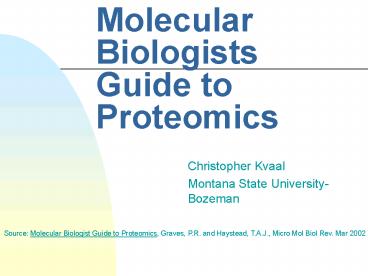Molecular Biologists Guide to Proteomics - PowerPoint PPT Presentation
1 / 24
Title:
Molecular Biologists Guide to Proteomics
Description:
Source: Molecular Biologist Guide to Proteomics, Graves, P.R. and Haystead, ... Bioinformatics. Storing, Organizing, and Analyzing Sequence Data. Functional Genomics ... – PowerPoint PPT presentation
Number of Views:60
Avg rating:3.0/5.0
Title: Molecular Biologists Guide to Proteomics
1
Molecular Biologists Guide to Proteomics
- Christopher Kvaal
- Montana State University-Bozeman
Source Molecular Biologist Guide to Proteomics,
Graves, P.R. and Haystead, T.A.J., Micro Mol Biol
Rev. Mar 2002 pp 39-63
2
Topics of Discussion
- Review
- Introduction to Proteomics
- Technology of Proteomics
- Applications of Proteomics
3
Review
- Bioinformatics
- Storing, Organizing, and Analyzing Sequence Data
- Functional Genomics
- Contextual Use of Bioinformatic Data
- i.e. DNA Array or SAGE
- Proteomics
4
Why do we have these new disciplines?
- To much information
- What do we do with all the sequence data?
- 45 microorganism genomes have been sequenced and
170 more are in progress - 5 eukaryotes have been completed
- Saccharomyces cerevisiae
- Schizosaccharomyces pombe
- Arabodopsis thaliana
- Caenorhabditis elegans
- Drosophilia melanogaster
- Rice, Mouse and Human are nearly done
- 2/3 of all genes identified have no known
function
5
Move over Genomeon to Proteomics
- If the genome is the blueprint of an
organism---who reads it? - The proteome is all the proteins that are called
for by the genome - At this point no computer algorithm can do this
- A computer can decode all 6 reading frames of an
organism - A computer can compare these.. But then what?
6
Genomic DNA
- Structure
- Regulation
- Information
- Computers cannot determine which of these 3 roles
DNA play solely based on sequence (although we
would all like to believe they can)
7
Introduction to Proteomics
- Definitions
- 1. Classical - restricted to large scale
analysis of gene products involving only proteins - 2. Inclusive - combination of protein studies
with analyses that have genetic components such
as mRNA, genomics, and yeast two-hybrid - Dont forget that the proteome is dynamic,
changing to reflect the environment that the cell
is in
8
1 gene 1protein?
- 1 gene is no longer equal to one protein
- In fact, the definition of a gene is
debatable..(ORF, promoter, pseudogene, gene
product, etc) - 1 genehow many proteins
9
Why Proteomics?
10
Why Proteomics?
- Annotation of genomes, i.e. functional annotation
- Genome proteome annotation
- Protein Function
- Protein Post-Translational Modification
- Protein Localization and Compartmentalization
- Protein-Protein Interactions
- Protein Expression Studies
- Differential gene expression is not the answer
11
Cell Specific Expression
- All cells in a metazoan organism contain the same
genomic DNA - How does a genome project answer the question of
why liver specific genes are not expressed in
brain?
12
Types of Proteomics
- Protein Expression
- Quantitative study of protein expression between
samples that differ by some variable - Structural Proteomics
- Goal is to map out the 3-D structure of proteins
and protein complexes - Functional Proteomics
13
Technology of Proteomics
- Separation and Isolation of Proteins
- 1D and 2D PAGE
- Edman Sequencing
- Mass Spectrometry
- Database utilization
14
Technology of Proteomics
- How do you separate proteins.PAGE
- Has not changed in the 32 years since its
inception..the question answered is still the same
15
Technology of Proteomics
- Edman (N-terminal) Sequencing
- Introduced in 1949
- Run PAGE then Sequence
- Alternative to PAGE
- Digest whole protein mixture
- Start sequencing
- Only works with High Abundance Proteins
16
Technology of Proteomics
- Mass Spectrometry (MS)
- Enables peptide mass and sequence to be obtained
- Faster, more sensitive, more difficult and more
expensive
17
Applications of Proteomics
- Characterization of Protein Complexes
- Protein Expression Profiling
- Yeast Genomics and Proteomics
- Proteome Mining
- Protein Arrays
18
Proteome Mining
- A functional proteomics approach
- A Proteome Mine Example
- ATP is immobilized to beads in protein kinase
conformation - Total protein is mixed the beads and the mixture
washed - Remaining proteins isolated and
identifiedprotein kinases, and purine dependent
metabolic enzymes - Immobilize a putative drug to bead and test for a
cellular ligand
19
Yeast Genomics and Proteomics
- First example of the 2-omics used in a
complementary fashion - Comparative proteome experiment identified
over-expressed proteins - Protein info used to design genetic experiments
and verify finding
20
Protein-Protein Interactions
- Yeast two-hybrid system
- Establish the role of a protein with a guilt by
association argument - Organism wide (S. Cerevisiae) comparision
- 6000 ORFs systematically compared in a matrix
- Are we crazy, how to interpet the results
21
Protein Arrays
- Another Functional Proteomics Approach
- Same concept as a DNA Array
- Has been published in a peer-reviewed journal
22
(No Transcript)
23
Challenges of Proteomics
- The Native-conformation question
- Proteins cannot be studied with the scale, speed,
sensitivity and reliability that nucleic acids
achieve - Low-abundance proteins may be the most important
class of proteins and the most difficult to study
with current methodologies - One of you needs to go out and invent Protein
PCR
24
The End































